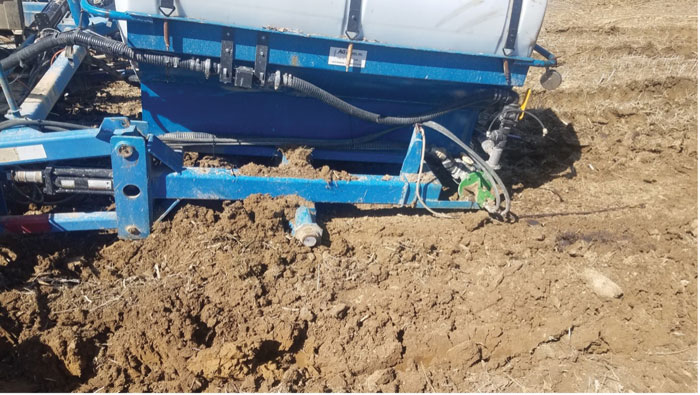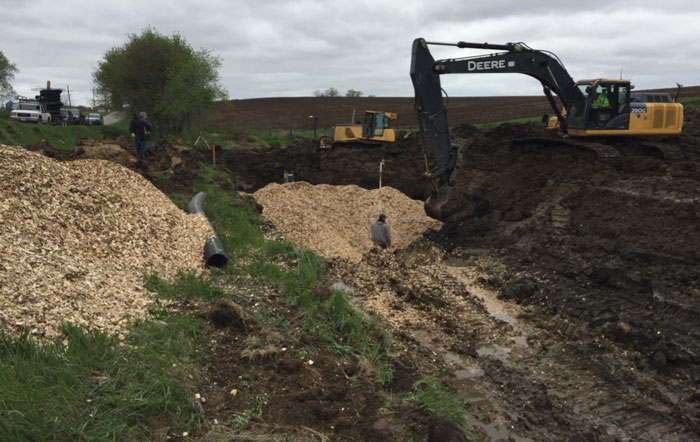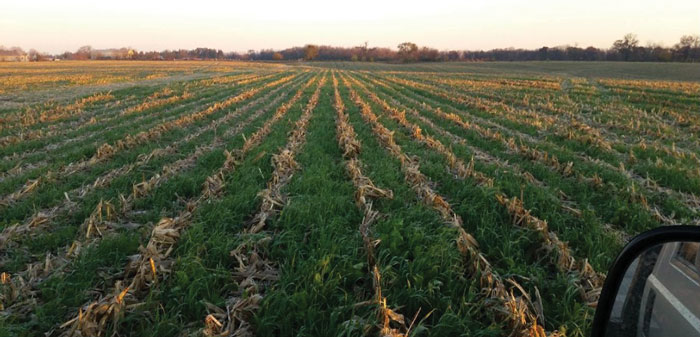Robb Ewoldt, along with his wife, Jennifer, and teenage sons, Alex and Isaac, grows corn and soybeans in eastern Iowa, just three miles north of the Mississippi River. He farms 2,000 acres with a main goal always in mind.
“We need to grow a lot of food for a lot of people in this world,” Ewoldt says. “We need to produce as many calories as we can per acre but do it in a responsible manner.”
Ewoldt shoots for a 275-bushel average for corn and 75-bushel average for beans on his best soils. His goal isn’t quite as lofty on grounds with lower soil quality, but it’s significantly higher than it used to be.
“Ten years ago, our yield goal was 195 on tougher clay, timber soils. Now, last year we averaged 225 on that clay ground. We’ve gone up 30 bushels in a decade. That’s what our farming practices have done for us.”
Ewoldt relies on what he calls “the trifecta” to boost yields while improving soil and water quality at the same time. The trifecta includes nutrients (timing and placement), equipment (technology to cut down on fertilizers) and cover crop/edge of field conservation practices.
Nutrient Management
The sixth-generation farmer is the first in his family to run a no-till and strip-till system. He strip-tills corn and no-tills non-GMO soybeans.
“For corn-on-bean ground in the spring we go with three passes of nitrogen (N) and a little bit of phosphorus (P), potassium (K) and sulfur (S) along the way,” Ewoldt says. “We put that in with an N stabilizer because in Iowa our number one concern is nitrates getting into the water streams. We perform nitrate soil tests in the fall to determine our levels. The sidedress and Y-drops are applied when the corn is 10-14 days before tassel.”

A LEARNING EXPERIENCE. Ewoldt was strip-tilling a 34-acre field when an axle fell off. For the remaining 17 acres, he had to dribble his fertilizer on the surface. At harvest, the ground with nutrients placed in the strips out-yielded the ground with the dribble by 35 bushels per acre.
For the first pass with the strip-till bar, Ewoldt applies roughly 100 pounds per acre of N, 50 pounds of P, 80 pounds of K, 5 pounds of S and a small amount of micronutrients (zinc and boron) mixed in.
The second pass with the planter calls for roughly 40 pounds of N, 20 pounds of P and 5 pounds of sulfur. Ewoldt refers to the third and final pass with Y-drops as the “flex pass.”
“We use modeling to determine how much N we lost from the strips, and how much more we need to put on. It depends mainly on weather and crop conditions, but it’s usually 40-60 pounds.”
For non-GMO soybeans on corn ground, Ewoldt goes with a one-pass nutrient application (12 pounds N, 45 pounds P, 90 pounds K, 15 pounds S) in the spring. He uses a 15-inch dribble band applicator, which he admits is a work in progress.
“I just haven’t figured out how to get that fertilizer where we want it on our bean ground which is why we dribble it on top,” he says. “Doing non-GMO beans in a no-till situation is challenging to say the least.”
Ewoldt runs a two-year rotation on most of his land but next to his hog site where manure can be utilized as fertilizer, he goes with 3 years of corn followed by 1 year of soybeans. Ewoldt applies 3750 gallons per acre of hog manure supplemented with synthetics for a total of 170 pounds N, 90 pounds P, 140 pounds K and 14 pounds S with N stabilizer in the fall, followed in the spring by a pass with the planter (40 pounds N, 5 pounds S) and a sidedress pass with Y-drops (60 pounds N).
Making a Difference
When he’s not busy farming or fulfilling duties as a director of the Iowa Soybean Association, Ewoldt is focused on making an impact in the community. His family hosts an open farm day every year, giving the public an opportunity to learn about his operation and conservation practices.
“There’s a lot of misinformation out there,” Ewoldt says. “That’s our big thing — we want to educate people. We want to engage them, and make sure they know they can trust us when it comes to supplying their food.”
Ewoldt and his wife, Jennifer, have been recognized numerous times for their commitment to conservation and agricultural advocacy. They are recipients of the Wergin Good Farm Neighbor Award, River Action’s Eddy Award, Iowa Farm Environmental Leader Award and the ISA Advocate for Agriculture Award.
“We’re planting corn-on-corn in the hog manure because we have 200 acres of crop ground right around a 2400 head hog site,” Ewoldt says. “Our hogs produce enough manure for 150 acres of corn.”
The manure is applied with Real-Time Kinematic (RTK) precision technology, which allows Ewoldt to plant directly on the manure strips in the spring. The manure application is used strictly for corn-on-corn, because the state of Iowa prohibits the usage of manure on bean ground, he says.
Equipped for the Job
Ewoldt tries to keep it as simple as possible with equipment. He uses a BLU-JET strip-till unit with a 16-row liquid applicator.
“There’s nothing really fancy about it, but it gets the job done for us,” Ewoldt says. “It has the tank on the back with parallel linkage to the tractor. It’s basically running a knife in the ground, applying the liquid fertilizer about 5-6 inches deep.”
Ewoldt discovered the true impact of strip-till on his farm thanks to an unintentional experiment. The axle on his strip-till bar snapped off during planting several years ago. He called his ag retailer for assistance.
“I had about 17 acres to go on bean stubble,” he says. “They brought out a three-wheel sprayer applicator. It had 15-inch drops to dribble the fertilizer on. We pumped off the tank, they went out and did the rest of the field that way.”

DENITRIFICATION PLANT. Ewoldt installed a bioreactor on the edge of his farm as a way to improve water quality. A hole in the ground with tile lines and a bunch of woodchips, the bioreactor removes about half of the field’s nitrate load.
Come harvest time, the ground with nutrients knifed into the strips ended up yielding 35-bushels more per acre than the ground with 15-inch dribble.
“You’re always going to learn when something bad happens,” he says. “We had been strip-tilling for 4 years, but until that moment I was never patient enough to do a side-by-side true comparison. Our yields have been gradually going up since we’ve been strip-tilling and we’ve cut down significantly on fertilizer costs, using about one-third less P and K.”
Ewoldt uses a 1997 Kinze 16-row planter, which has been modified over the years to include precision equipment. The bar is the only original thing on the planter, he says. The planter uses hydraulic down force to ensure seeds are being placed near target depth. He also uses Devastators on his corn heads, which pay off big time when planting season rolls around.
“Devastators would be the last thing I’d give up because they help break down corn stalks and get the fertilizer in the soil where I need it,” Ewoldt says. “It’s amazing how that stalk starts breaking down and gets more manageable.”
For seeding cover crops, Ewoldt goes with a Great Plains Turbo-Max 24-foot vertical-tillage machine. It’s durable, efficient, and easy to use, he says, covering a lot of ground quickly.
“I can go about 9 mph on it,” Ewoldt says. “All I want to do is move it around and get that rye in a little bit of contact with the soil. Not too many things can go wrong with that piece of equipment. I can put my 13-year-old son in there and not worry too much about what’s going to happen.”
A Cover Crop Epiphany
Ewoldt’s cover crop journey began in 1996. He planted cereal rye at first, “strictly for selfish reasons, to make cheap feed for cows,” he says. A drought year in 2005 changed his perspective.
“That’s when we had our ‘ah-ha’ moment,” Ewoldt says. “We planted beans into cereal rye. We grew 36 bushels per acre on the cereal rye ground. Where we had bare corn stalks, we only grew 12 bushels per acre. That told me there was something going on with cover crops we needed to explore a little bit more.”
Knee-High Cereal Rye
Cereal rye got “wooly and thick” on Ewoldt this past year after planting corn late due to cool and wet conditions. The rye was knee-high when he terminated later than normal.
“I was nervous when we were planting that corn,” he says. “I’ve never planted into anything that thick before. I walk out there now, and you can barely find any of it on top of the ground. I could not believe how many earthworms we found. I’m like, ‘this is what we’ve been working for.’”
Cover crops like cereal rye have been a staple on his farm for over 25 years. Ewoldt grows covers on about one-third of his 2,000-acre operation, he estimates.
Ewoldt has experimented with several species, including oats, clover, triticale, radish and winter wheat. Certain covers have worked better than others. Getting tillage radish established before frost was a struggle. There was also a rough experience with perennial ryegrass a few years ago.
“We thought the small seeds would be easy to fly on with a helicopter,” he says. “It was a complete disaster. The seeds were too light, they didn’t fly very far and it was very hard to kill in the spring.”
Ewoldt’s favorite covers are cereal rye and winter wheat. Rye has the edge for the top spot because “it’s idiot proof,” he says.
“Rye can grow anywhere. You can apply it a lot of different ways. You can drop it from an airplane, or you can spread it out with a fertilizer buggy.
“Winter wheat is my second favorite because it gives us a lot of bang for our buck. We can get it established early and it grows fast. I also like the tillering aspect of it.”
Ewoldt plants cereal rye on corn-on-corn ground before the fall application of manure. He terminates it, using Roundup, 3-4 days after planting the corn. For beans, he terminates right before planting.
Cover crops are helping boost yields, increase organic matter and hold N in place from fall-applied hog manure, Ewoldt says. Soil scientists from the Iowa Department of Animal Land Stewardship (IDALS) gave two thumbs up during a recent visit.
“The soil scientists came out last year and looked at our soil structure,” Ewoldt says. “They’re the professionals and they were impressed with what they saw. They didn’t know exactly where we were in the beginning, but when they looked at our soil, it’s a lot better, especially the clay ground.”
Living on the Edge
Ewoldt currently serves as the president of the Iowa Soybean Association (ISA). During his early days with the ISA he learned of farmers using bioreactors as a tool to improve water quality in the north central part of the state.
“I thought to myself, ‘nobody over in eastern Iowa has ever heard of that.’ So, I decided to do it.”

COVER CROP STRATEGIES. Ewoldt uses cover crops on one-third of his 2,000-acre operation to help increase organic matter and hold N in place from fall-applied hog manure. His top two cover crops are cereal rye and winter wheat.
Ewoldt gave it a shot in 2017, becoming the first in eastern Iowa to install a bioreactor, or a ‘denitrification plant,’ as he likes to call it. It’s essentially a buried trench on the edge of the farm, filled with woodchips. A bioreactor removes, on average, 43% of nitrate-nitrogen from water diverted through it, according to the Iowa Nutrient Reduction Strategy.
“The bioreactor takes out about half of our nitrate load,” Ewoldt says.
“It’s very pricey to install, but when you think about how long we’ll have it, 12-15 years, it’s a lot less expensive than cover cropping. When it comes to water quality, that’s about the cheapest way you can get good water coming off if you’ve got a lot of tiled ground.”
The installation of a pollinator habitat has also proven to be an edge of field moneymaker for Ewoldt. The federal government, through the Conservation Reserve Program (CRP), is paying him $205 an acre for the habitat, which provides foraging sites and structure for nesting bees and other wildlife. The habitat was established on 12 highly unproductive acres near trees and steep side hills.
“We were losing $250 an acre every year on those 12 acres,” he says. “Now, the CRP pays us $205 an acre and input costs to not farm the pollinator habitat
for 10 years. That’s a swing of $455. Plus, the average production on the nearby acres has jumped tremendously.”
A Bright Future
Conservation practices have improved his water and soil quality and boosted his bottom line, Ewoldt says. He’s observed the following benefits:
- Improved soil structure
- Increased water infiltration
- Decreased surface erosion
- Decreased nitrates in water samples
- Increased yields
- Less stress to crops from drought conditions
- Reduced fertilizer use
- Improved relationships with local conservation groups
“I wish my dad was alive to see what we’re doing,” Ewoldt says. “It would blow his mind.”
Reflecting on everything he’s learned since buying the farm from his parents in 2004, Ewoldt can’t help but smile thinking about the future and potentially passing the torch to his sons one day.
“My two boys are very involved in the operation and are learning a lot,” he says. “I’m very proud of them because I look at them as the next generation, and they’re so much further ahead when it comes to conservation efforts than I ever was at their age.”







